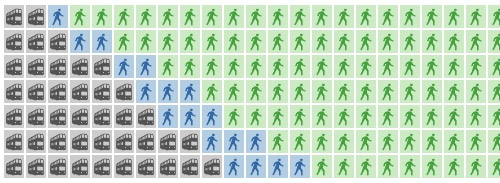Now we love gadgets and gizmos like Oliver Reed liked to quaff yards of ale, but sometimes the quickest answer to a question can be found by more low tech means.

For example, the guys at Visual Motive pondered over the thorny question of whether you’d be better off walking instead of taking the bus.
We’ve probably all faced this conundrum stuck at a bus stop. If you’ve only got a fairly short distance to travel – say you’re trying to get to the pub before closing time – it is better to wait for the bus or should you leg it? And exactly how long should you wait if you’re going for the bus option?
Instead of whipping out a trendy mobile app or melding some sort of interactive GPS walking gadget, they suggest you solve this thorny question via a good old fashioned table which gives you the facts in a no-nonsense manner.
The table can be found here and works on this basic rule of thumb: if you have N blocks to travel, you should only wait for the bus if it is less than N minutes away.
Of course, the table doesn’t take into account London’s perplexing system that sees no buses for an eternity and then a virtual procession of the things trundling down your road at once. Or – more likely – hurtling past you as you’re stuck between two stops after deciding to walk.



These people clearly don’t know anything about buses. Thirty miles an hour is completely unrealistic an average speed for a bus, especially in a town or city. I understand from a friend who worked in the timetabling office of a bus company that they allow for an average speed of eleven mph taking into account time spent at stops.
As for walking speed, this is more likely to be around two mph in such an environment rather than the popular idea that people walk at an average of four mph.
The only other factor you need is the frequency of the buses on that route. Given that they are not on their correct time because of traffic, you need to assume the worst possible wait based on the idea that you have just missed one. You then work out how much of your journey you can walk in that maximum waiting time.
It might be worth considering the price of the journey as well, and can you remember what they said about the weather on the news that morning? I think that as a rough guide any journey over half a mile will be be worth waiting for the bus if the frequency is ten minutes.
Of course if you have a free bus pass, just carry a book to read and just wait for the bus.
You’d probably get that speed in the countryside, but you’re right: 30mph is totally unrealistic for an urban environment (Traffic in central London famously moves at just 10mph – the same speed as horse-drawn carriages a century ago.)
The idea that people walk at 4mph is bunkum. Most go between 2-3.
I know this because my narrowboat goes a whopping 4mph and I can leave people in my wake, given an hour or so of traveling.
You need to know how long the bus is actually going to take to arrive, not just when it is due. I think the answer to this one *is* technology, actually.
We now have the tech. to provide real time running information on mobile phones, so you do a quick mental calculation as to how far away the bus actually is. Then going home you can wait in the warm pub until the last possible moment.
It wouldn’t be that expensive to provide this type info via flat screens at the stops as well, but sadly the equipment would get vandalised before you could say “next stop please”
I think TfL plans to introduce this service before long. I think it is an important step to making buses more than just a ‘distress’ option for those with no car.
@Tom
Your narrowboat may do a ‘whopping 4mph’ while it is moving but what about going through the locks? I often walk up the Grand Union Canal towpath at about the steady 2mph I mentioned in my post.
When there is a narrowboat around I notice that it gets ahead of me quite quickly, but when I arrive at the next lock, there is that same boat doing the business with the sluice gates and so on. I get ahead for a little while to hear it chugging gently along and going past me. This can repeat for a couple of hours but canal walking gets a bit boring after that amount of time especially if you keep seeing the same boat at the lock gates, so a detour into the country around is called for.
As with the bus you have to add in the stopping time to get the average speed.